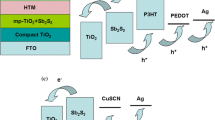Abstract
Nanostructured photoelectrochemical solar cells have been prepared by combining a Sb2S3-sensitized photoactive electrode, polyaniline nanobelts, and a Ag counter electrode to form a layered structure. Here, Sb2S3 acts as an absorbing semiconductor, and polyaniline acts as both a hole conductor and light absorber (a hole-conducting dye). Via the optimization that eventually determines the chemical bath deposition duration to be 3 h, the cell shows a high photovoltaic performance with 7.05 mA/cm2-short-circuit current density, 0.695 V-open-circuit voltage, 0.457 fill factor, and 2.24 % power conversion efficiency. The prepared devices are stable under room light in ambient conditions (even without encapsulation).






Similar content being viewed by others
References
He Z, Zhong C, Su S et al (2012) Enhanced power-conversion efficiency in polymer solar cells using an inverted device structure. Nat Photonics 6:591–595
Semonin OE, Luther JM, Choi S et al (2011) Peak external photocurrent quantum efficiency exceeding 100 % via MEG in a quantum dot solar cell. Science 334:1530–1533
Patel R, Ahn SH, Chi WS et al (2012) Poly (vinyl chloride)-graft-poly (N-vinyl caprolactam) graft copolymer: synthesis and use as template for porous TiO2 thin films in dye-sensitized solar cells. Ionics 18:395–402
Dou L, You J, Yang J et al (2012) Tandem polymer solar cells featuring a spectrally matched low-bandgap polymer. Nat Photonics 6:180–185
Nishioka K, Sueto T, Saito N (2009) Formation of antireflection nanostructure for silicon solar cells using catalysis of single nano-sized silver particle. Appl Surf Sci 255:9504–9507
Itzhaik Y, Niitsoo O, Page M et al (2009) Sb2S3-sensitized nanoporous TiO2 solar cells. J Phys Chem C 113:4254–4256
Boix PP, Larramona G, Jacob A et al (2011) Hole transport and recombination in all-solid Sb2S3-sensitized TiO2 solar cells using CuSCN as hole transporter. J Phys Chem C 116:1579–1587
Savadogo O, Mandal KC (1993) Low-cost technique for preparing n-Sb2S3/p-Si heterojunction solar cells. Appl Phys Lett 63:228–230
Vogel R, Hoyer P, Weller H (1994) Quantum-sized PbS, CdS, Ag2S, Sb2S3, and Bi2S3 particles as sensitizers for various nanoporous wide-bandgap semiconductors. J Phys Chem 98:3183–3188
Itzhaik Y, Niitsoo O, Page M et al (2009) Sb2S3-sensitized nanoporous TiO2 solar cells. J Phys Chem C 113:4254–4256
Chang JA, Rhee JH, Im SH, Lee YH, Kim HJ, Seok SI, Gratzel M (2010) High-performance nanostructured inorganic–organic heterojunction solar cells. Nano Lett 10(7):2609–2612
Sirimanne PM, Tributsch H (2004) Parameters determining efficiency and degradation of TiO2/dye/CuI solar cells. J Solid State Chem 177:1789–1795
Nanu M, Schoonman J, Goossens A (2004) Inorganic nanocomposites of n-and p-type semiconductors: a new type of three-dimensional solar cell. Adv Mater 16:453–456
Xia J, Masaki N, Lira-Cantu M et al (2008) Influence of doped anions on poly (3, 4-ethylenedioxythiophene) as hole conductors for iodine-free solid-state dye-sensitized solar cells. J Am Chem Soc 130:1258–1263
Tan SX, Zhai J, Wan MX et al (2003) Polyaniline as a hole transport material to prepare solid solar cells. Synth Met 137:1511–1512
You X, Zou G, Ye Q et al (2008) Ruthenium (II) complex-sensitized solid-state polymerization of diacetylene in the visible light region. J Mater Chem 18(39):4704–4711
Lan Z, Wu J, Lin J et al (2010) Dye-sensitized solar cell with a solid state organic–inorganic composite electrolyte containing catalytic functional polypyrrole nanoparticles. J Sol-Gel Sci Technol 53(3):599–604
Messina S, Nair MTS, Nair PK (2007) Antimony sulfide thin films in chemically deposited thin film photovoltaic cells. Thin Solid Films 515:5777–5782
Messina S, Nair MTS, Nair PK (2009) Solar cells with Sb2S3 absorber films. Thin Solid Films 517:2503–2507
Lan Z, Zhang X, Wu J et al (2013) A novel photoelectrochemical solar cell with high efficiency in converting ultraviolet light to electricity. Electrochim Acta 108:337–342
Kongkanand A, Tvrdy K, Takechi K et al (2008) Quantum dot solar cells. Tuning photoresponse through size and shape control of CdSe-TiO2 architecture. J Am Chem Soc 130:4007–4015
Hetsch F, Xu X, Wang H, Kershaw SV, Rogach AL (2011) Semiconductor nanocrystal quantum dots as solar cell components and photosensitizers: material, charge transfer, and separation aspects of some device topologies. J Phys Chem Lett 2(15):1879–1887
Xiaoping Z, Zhang L, Jihuai W et al (2013) Enhancing photovoltaic performance of photoelectrochemical solar cells with nano-sized ultra thin Sb2S3-sensitized layers in photoactive electrodes. J Mater Sci Mater Med 24(6):1970–1975
Pommerehne J, Vestweber H, Guss W et al (1995) Efficient two layer leds on a polymer blend basis. Adv Mater 7(6):551–554
Ganteför G, Gausa M, Meiwes-Broer KH et al (1990) Photoelectron spectroscopy of silver and palladium cluster anions. Electron delocalization versus, localization. J Chem Soc Faraday Trans 86(13):2483–2488
Acknowledgments
This work was supported by the NNSF of China under grant 21327001.
Author information
Authors and Affiliations
Corresponding author
Rights and permissions
About this article
Cite this article
Zhang, X., Lan, Z., Cao, S. et al. Nanostructured photoelectrochemical solar cells with polyaniline nanobelts acting as hole conductors. Ionics 21, 1781–1786 (2015). https://doi.org/10.1007/s11581-014-1316-8
Received:
Revised:
Accepted:
Published:
Issue Date:
DOI: https://doi.org/10.1007/s11581-014-1316-8




